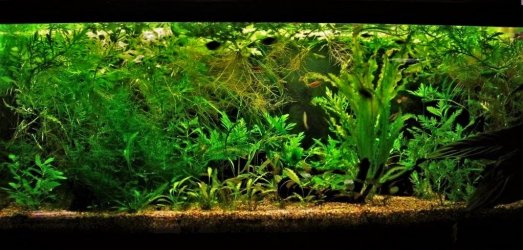I have kept this fish twice, and spawned them the second time when I had a group of six with obviously male/female present. As has been said, this species requires true pristine water, of the appropriate parameters (I had/have zero GH/KH and the pH in the 4-5 range. I was lucky to have this out of my tap; preparing water would significantly increase the work for this species. They are highly prone to skin problems (my first attempt fish were killed by velvet). The tank pictured below was for the second group some years later, and resulted in spawning and fry grew well. Then along came a wood fungus and killed the lot of them. The following is a profile I wrote for another site.
Sphaerichthys osphromenoides
Family: Osphronemidae, Subfamily Luciocephalinae.
Common Names: Chocolate Gourami
Origin and Habitat: Malaysian Peninsula, Sumatra and Borneo. Found in peat swamps and blackwater streams in densely forested areas.
Compatibility/Temperament: Peaceful and timid; males are territorial but if given enough room no injury should result. Best in a species habitat, or may be combined with similar fish having the same water parameter requirements, such as the other three related "Chocolate" gourami species, pygmy sparkling gourami, croaking gourami, rasbora, small-species loaches, shrimp.
Diet Despite a reputation for "fussy," it readily accepts prepared foods like flake and frozen; frozen bloodworms and daphnia are relished.
Size Grows to 2.5 inches maximum.
Minimum Tank Suggestion 15-20 US gallons for a pair but preferably larger.
Water parameters
Very soft (hardness below 5 dGH) acidic (pH 4 to 6.5 but preferably below 6.0) water, temperature 26-31C/79-88F. In hard or basic water the fish will be stressed. Very prone to skin parasites in unsuitable water parameters or conditions.
Description
One of the most delicate and sensitive of the anabantid fishes, but worth the effort in providing the proper environment. A very social species, it must be kept in numbers that will allow it to develop natural behaviours within the group, some of which are fascinating to observe. It requires a well-planted tank with a good covering of floating plants such as Ceratopteris (Water Sprite) and the stem plant Hygrophila difformis (Wisteria) that can be grown such that it continues to extend across the surface. These will also help to keep the light subdued; this species does not do well in brightly-lit aquaria. And the filter flow must be as little as possible, a small sponge filter or a slow-flow canister is ideal.
It is highly sensitive to water parameters and quality, and should only be introduced to a well matured and biologically balanced planted aquarium. Regular partial water changes maintaining water quality stability are essential. Fluctuations in water parameters or quality often lead to skin parasites, bacteria, and fungus. The temperature should remain at or above 80F.
Males have a light (creamy white) edge to the dorsal and anal fins, and females have a dark spot on the caudal fin; males may have a reddish-brown hue over the body. Unlike many of the anabantids that are bubblenest spawners, this species is a maternal mouthbrooder. The pair circle each other and the eggs are laid on the substrate in a shallow depression, then immediately picked up by the female and retained in her bucal cavity for up to 14 days before the fry are released. With a thick cover of floating plants, several fry will usually survive.
In common with all the species in the suborder Anabantoidei, this fish possesses an auxiliary breathing organ called the labyrinth, named because of the maze-like arrangement of passages that allow the fish to extract oxygen from air taken in at the surface. The fish must use this accessory method, and it allows the fish to live in oxygen-poor muddy waters. To accommodate this, the aquarium must be kept covered to maintain warm moist air above the surface.
This species is nearly identical to Sphaerichthys selatanensis [Vierke 1979] which was originally considered a sub-species; Roberts (1989) established the latter as a distinct species, confirmed by Kottelat et al. (1993). S. osphromenoides has a third vertical creamy-white band running from just before the dorsal fin at the top to just behind the ventral fins at the bottom; this is not present on S. selatanensis. There are now four recognized distinct species within the genus, the other two less commonly seen being S. acrostoma and S. vaillanti.
This fish was described in 1860 by G. Canestrini. The genus name derives from the Greek for a conglobate or spheric fish. The species epithet is also from the Greek and means "to look like osphromenus," a reference to the Giant Gourami, Osphronemus gorami.
References:
Kottelat, Maurice, A. J. Whitten, S. N. Kartikasari and S. Wirjoatmodjo (1993), Freshwater fishes of Western Indonesia and Sulawesi, Periplus Editions, Hong Kong.
Roberts, T.R. (1989), "The freshwater fishes of Western Borneo (Kalimantan Barat, Indonesia)," Memoirs of the California Academy of Science, Number 14.


